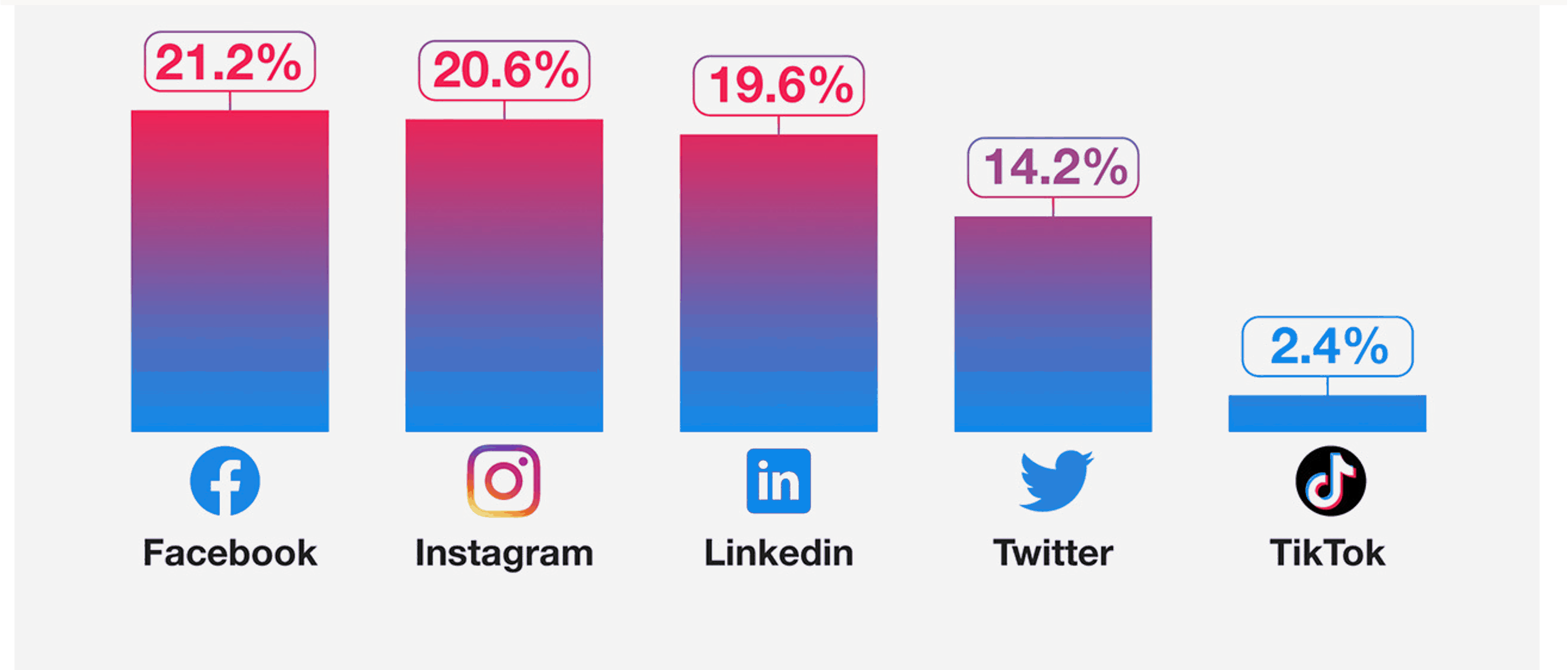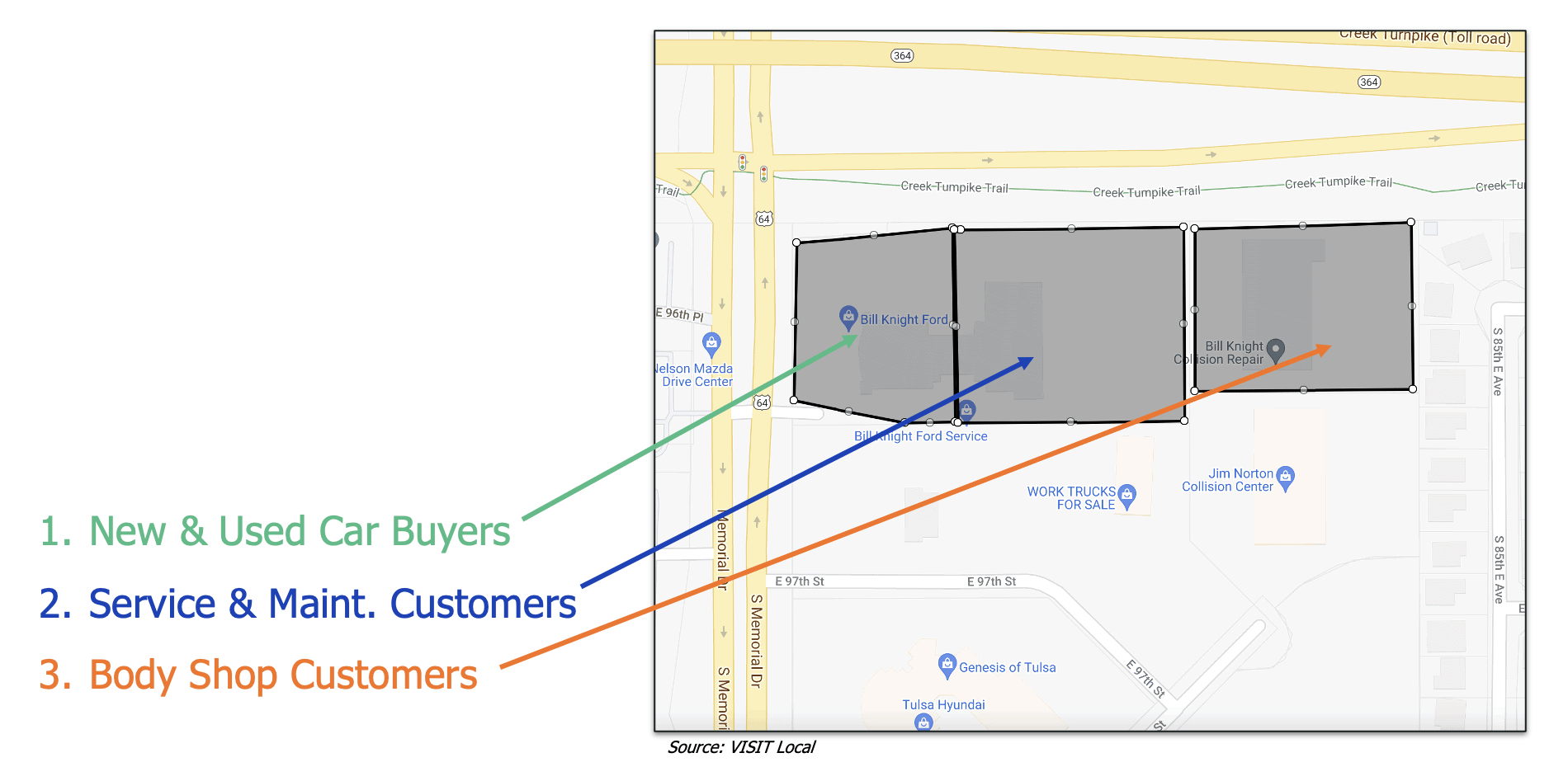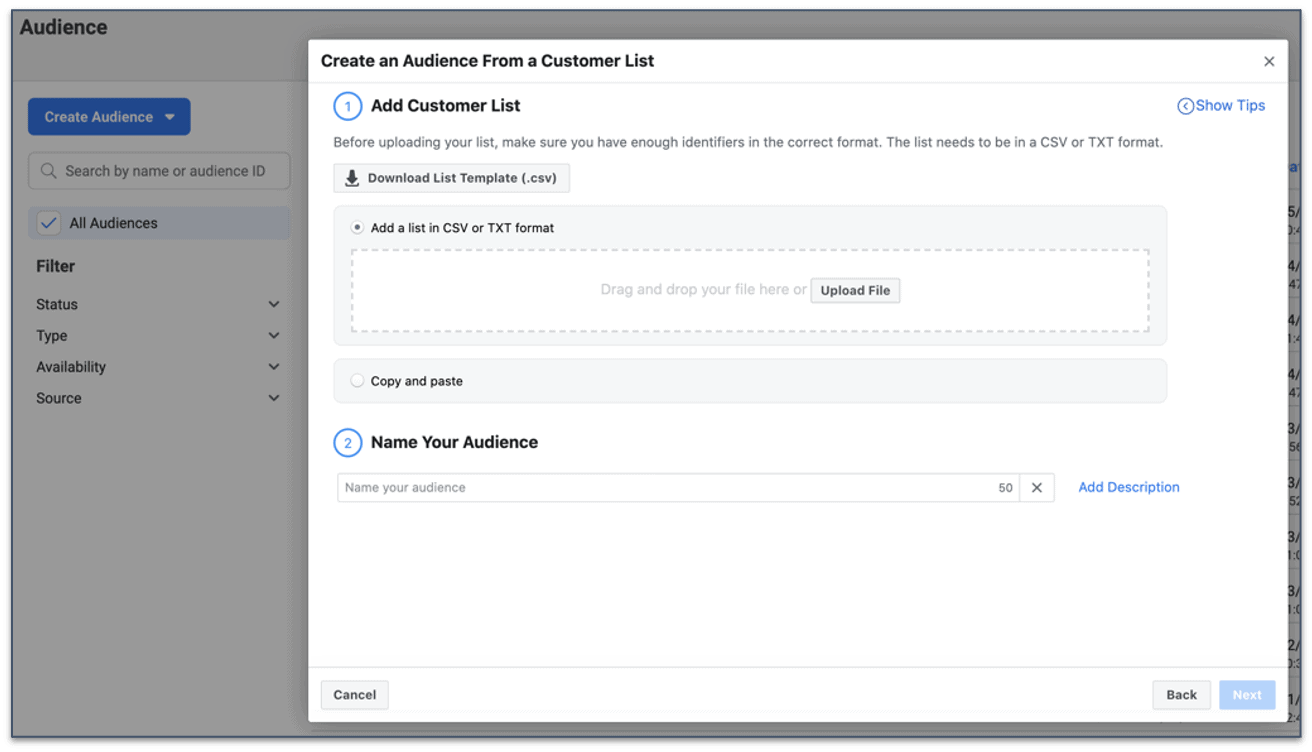Facebook, Instagram, TikTok: Using the Big Three to Drive Store Traffic
February 13, 2023 by
Social media ads are more effective than ever, and location events strongly predict future behaviors. Advertising to custom audiences on social media allows marketers to target the most relevant, high-intent shoppers. Knowing how to capitalize on the big three social media ad platforms — TikTok, Facebook, and Instagram — to drive foot traffic to your stores, restaurants and other retail locations is more important than ever.
In this post you’ll learn:
- How to drive store traffic using social media ads
- Key differences between the big three social channels
- How to maximize conversions on TikTok, Facebook, and Instagram
- TikTok or Instagram Reels: How to decide
- Using custom audiences to eliminate wasted ad spend
The Post-Pandemic Environment
It’s no surprise that brands and retailers across every industry saw a significant decrease in store visits throughout 2020 and 2021. The good news is that consumer attitudes and behaviors have changed. Consumers of every age demographic are shopping, dine in at a restaurant or see a movie. Consumer comfort levels are back to typical levels, and brands have an opportunity to capitalize on this change.
Consumer Trends on the Rise
As people visit brick and mortar stores, they’re not the same shoppers they were before the pandemic. Instead, shopping locally has become a staple in most households as they try and support their communities. Because of this, 82 percent of shoppers report shopping locally, and 71 percent will do it even if it’s less convenient or more expensive.
Social Media Landscape
At Reveal Mobile, we conducted research to see what advertisers and marketers were doing to drive sales in the post-pandemic era. An overwhelming majority, 70 percent, said they were using social channels to create online and in-store purchases. Local businesses, in particular, were capitalizing on the effectiveness of social channels, with 94 percent using social media and 70 percent using it to advertise and drive sales. Local businesses are not alone in this phenomenon; out of the $140 billion pumped into digital advertising each year, $40 billion is spent on social media.
Advertising on the Big Three
Ads on Facebook, Instagram, and TikTok have proven to be very profitable for brands and retailers. But understanding the nuances of each platform will help you grasp what your brand or agency needs to adopt to maximize your success.
Saturation
With so much ad budget being allocated to paid social, the landscape can become saturated. The good news is that despite the crowding, ads perform across all channels. For example, on Facebook, Instagram, and LinkedIn, about 20 percent of posts in-feed are ads. This is largely because every brand, agency, and retailer has tapped into the potential of these channels. Other social media platforms like TikTok have much less saturation, with 2.4 percent of posts being ads. This presents an excellent opportunity for brands to take advantage of and have their ads stand out.

Growth
When it comes to social media advertising, everyone knows about Facebook’s potential. But what many overlook is the enormous popularity apps like TikTok and Instagram have to offer. In June of 2021, the top three most downloaded social apps were TikTok, Facebook, and Instagram. With millions of downloads worldwide, you can no longer ignore the potential of emerging and current social apps. It’s obvious these sites are an excellent way for brands, agencies, and retailers to reach customers.
Demographics
To better understand how to capitalize on each app, it’s important to know who’s using it.
- Facebook is dominated by 25-34-year-olds. When all age groups 18 and up are counted, more than 94 percent of Facebook users have money to spend in the form of disposable income. These users are also spending 38 minutes a day on average using the app. This makes Facebook an extremely profitable channel for brands and retailers.
- Similar to Facebook, Instagram is dominated by 25-34-year-olds, but Instagram skews higher in terms of female users. The majority of Instagram users are out of their tween years and are ready and able to spend money. Although people spend less time on the app than they spend on Facebook, just 29 minutes per day, Instagram has proven to be an even more profitable channel for brands and retailers than Facebook.
TikTok
- For many, TikTok is the great unknown. The app is relatively new, so agencies and brands are just starting to tap into its potential. One of the biggest mistakes companies make when evaluating TikTok is that only tweens and teens use the app. While younger people make up about a third of users, 88 million TikTok users over 20 years old have a disposable income. TikTok is also used more each day by users than Facebook or Instagram, which means brands have a better opportunity to grab consumer’s attention and interact with them.
Moving Product
What makes social media the golden egg of advertising is its ability to compel people to buy. And to no one’s surprise, the big three apps have no trouble generating revenue for brands. But many may be shocked to find out that when it comes to purchase intent, Facebook does not dominate. Only 41 percent of Facebook users have made a purchase of a product they saw on the app as compared to 49 percent of TikTok users. Facebook is still able to influence an incredible amount of purchase decisions, but TikTok and Instagram can’t be left in the dust. TikTok is so influential in the consumer purchase decision there is even a viral hashtag called #TikTokMadeMeBuyIt. That being said, Instagram has proven to be the most fruitful channel moving products with 72 percent of users buying products they’ve seen on the app.
Average Ad Rates
So how much does it cost to run ads on these channels? It depends on what industry your company is in. Luxury is different from cosmetics, and cosmetics will not be the same as clothing. Because of this, averages are taken across all industries to give a birds-eye view of ad rates on social media.

Currently, Facebook has the highest cost per click at $0.97, and TikTok is the cheapest at only $0.19. What’s more interesting to examine is the click-through rate. Both Instagram and Facebook are just under 1 percent, but TikTok is significantly higher at 3 to 12 percent. This is in large part due to TikTok’s business model. TikTok uses the slogan “don’t make ads, make TikToks.” As a result, brands and retailers work their content into people’s feeds so seamlessly that the audience doesn’t realize they’re interacting with an ad. Because of this, TikTok dominates the click-through rate and often has excellent engagement metrics.
Reels vs. TikTok
When it comes to short-form video content, many brands and agencies are asking the same question: should we use Instagram Reels or TikTok? The short answer is: it depends.
To give some context, both Instagram Reels and TikTok give users a platform to post short videos that other people can watch and interact with. TikTok was the first platform to come up with this formula, so many social media users view TikTok as the original and reels as a copycat.
A key difference between the two is how content is served to users. TikTok’s algorithm is based on consumer’s content preferences. The For You Page on TikTok serves users videos based on the content they like and interact with. Because of this, everyone’s page is personal and unique. For example, if you engage with lots of sports videos, the algorithm knows to serve you more sports videos. Reels, on the other hand, serve content that is more connected to who you follow. So if you follow Justin Bieber on Instagram, you will likely see reels from not only Justin himself but other fan or paparazzi accounts. The Reels algorithm also takes into account users’ content preferences, but it’s not as sophisticated as TikTok’s.
Reels and TikTok also offer different video editing capabilities. In TikTok, there’s a feature called “sound sync,” which allows you to upload multiple clips at once, and then TikTok automatically organizes the clips to match the audio. On Reels, users have to manually cut and synchronize the clips to the audio. Because of this, many creators make their videos on TikTok and upload the TikTok to Instagram reels.
It’s also important to note that the reason people use Instagram is different from the reason people use TikTok. Until recently, Instagram was primarily a photo-sharing app. The primary purpose people use Instagram is to look at photos of their friends. TikTok is different because its main purpose is to watch short-form videos. So although Instagram users can watch Reels, many won’t. Many will use Instagram without ever venturing over to the Reels tab. On TikTok, users are served videos immediately when they open the app, but Instagram users have to actively search out Reels. This difference plays a huge role in the potential success of each platform.
Influencers and Celebrities
So now you’re probably wondering which platform you should use. Depending on your goals and strategy, it will influence which platform is better for your company. If you utilize influencers and celebrities in your ads, TikTok has proven to be a much better channel in terms of engagement. Take a look at this video Justin Bieber posted to his TikTok and his Reel.
This simple dance challenge did significantly better in TikTok with a 49% engagement rate compared to 3% on Instagram Reels. Bieber is not alone in the phenomenon, most influencers see better metrics on TikTok. Because of this, TikTok has proven to be a more fruitful channel for celebrities and influencers across the board.
Brands and Retailers
If your ads take a more traditional approach, Instagram may be a better bet. Watch this Reel posted by Burger King. (One downside to Reels is that users are unable to download Reels for off-app usage, so we have to use a link to Instagram in order to view the Reel.)
When ads were analyzed across Instagram and TikTok for brands, Instagram Reels performed better with a 12% impression rate compared to a 5% impression rate on TikTok. This is likely due to the fact that many brands have an existing social media following on Instagram and are just now diving into TikTok. This means the tides could change in the future as brands become more sophisticated on TikTok, but for right now, Reels remain king.
Brand and Retailer Challenges
Retail Touchpoints, a trade publication focused on retailers and their interaction with customers, conducted a study on retailers’ challenges at getting repeat purchases at their stores. Overall, the results found that retailers simply don’t have the proper data and technology. The inability to collect quality customer data made retargeting challenging. On top of that, many retailers need data that is not available to them or requires technology they don’t have.
The solution? Location-based marketing campaigns. The key to unlocking online to offline campaigns is by using location data. Although utilizing location data for campaigns is not new, nearly 90 percent of marketers use it in some form or fashion, and 60 percent use it to drive personalization. So, where do you begin with location-based marketing, and what does it look like? Let’s dive in.
Example Facebook Ad Campaign
A Ford dealership in Chicago has noticed that many people come to its showroom and lot but few return. This is puzzling for the dealership because these customers show high purchase intent when they come all the way to the dealership, yet purchases are down. The dealership decides it needs to start improving how it runs ads.
The challenge to advertising for the dealership is that not everyone has the same needs. Some customers are looking to buy a new or used car, others come in for routine service, and the rest need repair in the body shop. The dealership has social media ads for all of these customer segments, but it’s having trouble targeting the right customers. Facebook allows the dealership to use a radius to capture people near the dealership, but this serves ads to the people in the surrounding business. This has led to lots of ad spend waste for the dealership.

To rectify its campaign goals, the dealership implements a geofencing marketing tool. The tool allows the dealership to build custom geofences around specific areas of the dealership.

When a customer walks into the geofence, the marketing tool captures the mobile ad ID of that customer. The dealership can then download those mobile ad IDs and upload them to Facebook to create a custom audience. The dealership can then serve ads to only the people in the custom audiences. So customers who come in for routine service are served ads about the service garage. This makes ads relevant and meaningful to the dealership’s customers.
Example Instagram Ad Campaign
Nordstrom knows it has a strong customer base, but recently it noticed its store foot traffic was down. Even though customers were willing to drive more than 5 miles for the store experience, Nordstrom was still struggling to get people in the door. When they looked at the industry as a whole, they realized that store foot traffic was down across the board. Because of this, Nordstrom knew something needed to change in order to gain new customers and increase foot traffic.

Using a location-based marketing platform, Nordstrom can see its customers also shop at places like Ann Taylor and T-Mobile stores. This is extremely helpful because Nordstrom now knows where else its customers are going. Nordstrom is well aware of its competitors but didn’t realize its customers frequented other stores like T-Mobile until now.

Since Nordstrom knows Ann Taylor and T-Mobile customers have an affinity toward Nordstrom, Nordstrom has an advantage when it comes to targeting customers. Using the geofencing platform, Nordstrom is now able to geo conquest its competition and other relevant stores. By placing geofences around Ann Taylor and T Mobile, Nordstrom is able to collect the mobile ad IDs of the customers who entered those stores. Then, Nordstrom can serve ads to those people to drive business to Nordstrom.
So how does Nordstrom take the data they receive from the geofences and use it for advertising? Nordstrom can download a list of all the mobile ad IDs that entered its geofences and then upload that list to advertise on social media. The key to success in social media advertising is using custom audiences. In the ads manager of a social platform, like the one for Instagram shown here, you can create a custom audience using a mobile ad ID list. Once the list is uploaded, you can select manual placements, allowing you to isolate where your ads are served. So you can choose Instagram Reels or Stories, for example. By uploading the list of mobile ad IDs, you can target a hyper-specific audience and reduce ad spend waste, all because you can see where your customers are going.

Your target audience who entered the stores you geofenced is then served your amazing ads. Like these ads, Nordstrom served to its audience, and your business can also get raving comments like “the best Nordstrom advertising I’ve seen in years.”

Example TikTok Ad Campaign
Olive Garden has noticed its foot traffic has been down recently, and because of it, same store sales have significantly slowed. Even worse, Olive Garden’s competitor’s foot traffic has risen, indicating they’re stealing market share. Because of this, Olive Garden knew it had to innovate.

Using VISIT Local, Olive Garden could create geofences around all its restaurants in a given area, region, or nationwide. It could also geo conquest its competitors, those taking share, like Chili’s and Pizza Hut. From those geofences, Olive Garden can access all the mobile ad IDs that have been seen at its restaurants or the competitions’ locations. Olive Garden could then upload those MAIDs to TikTok to create a custom audience, giving them an ideal in-market audience for their food.
Because the custom audience allows Olive Garden to target high intent customers, they could significantly reduce wasted ad spend. Using the VISIT Local platform, Olive Garden could also see the impact of their media buys during and after the campaign, including the number of restaurant visits by day. This takes the guesswork out of campaign effectiveness. Olive Garden can efficiently track foot traffic conversions and quantify the number of visits from TikTok ads. That figure multiplied by the dollar value of a visit is the total upside. Divide that dollar figure by the media cost, and Olive Garden has a healthy ROAS to show its brand managers and business leaders.

Without the custom audience, Olive Garden could have been spending on TikTok ads without being able to connect that spend to foot traffic conversion or ROI. If you want to get the most out of your TikTok ads, custom audiences using location data are a must.
So now you know how to run successful campaigns on the big three social media platforms. If you have any questions about using location-based custom audiences on Facebook, Instagram or TikTok to drive retail foot and store traffic, get in touch.


Want to learn more about using custom audiences on TikTok, Facebook, and Instagram?
Grab the free guide